Junghyup Lee
Subnet-Aware Dynamic Supernet Training for Neural Architecture Search
Mar 13, 2025Abstract:N-shot neural architecture search (NAS) exploits a supernet containing all candidate subnets for a given search space. The subnets are typically trained with a static training strategy (e.g., using the same learning rate (LR) scheduler and optimizer for all subnets). This, however, does not consider that individual subnets have distinct characteristics, leading to two problems: (1) The supernet training is biased towards the low-complexity subnets (unfairness); (2) the momentum update in the supernet is noisy (noisy momentum). We present a dynamic supernet training technique to address these problems by adjusting the training strategy adaptive to the subnets. Specifically, we introduce a complexity-aware LR scheduler (CaLR) that controls the decay ratio of LR adaptive to the complexities of subnets, which alleviates the unfairness problem. We also present a momentum separation technique (MS). It groups the subnets with similar structural characteristics and uses a separate momentum for each group, avoiding the noisy momentum problem. Our approach can be applicable to various N-shot NAS methods with marginal cost, while improving the search performance drastically. We validate the effectiveness of our approach on various search spaces (e.g., NAS-Bench-201, Mobilenet spaces) and datasets (e.g., CIFAR-10/100, ImageNet).
Toward INT4 Fixed-Point Training via Exploring Quantization Error for Gradients
Jul 17, 2024Abstract:Network quantization generally converts full-precision weights and/or activations into low-bit fixed-point values in order to accelerate an inference process. Recent approaches to network quantization further discretize the gradients into low-bit fixed-point values, enabling an efficient training. They typically set a quantization interval using a min-max range of the gradients or adjust the interval such that the quantization error for entire gradients is minimized. In this paper, we analyze the quantization error of gradients for the low-bit fixed-point training, and show that lowering the error for large-magnitude gradients boosts the quantization performance significantly. Based on this, we derive an upper bound of quantization error for the large gradients in terms of the quantization interval, and obtain an optimal condition for the interval minimizing the quantization error for large gradients. We also introduce an interval update algorithm that adjusts the quantization interval adaptively to maintain a small quantization error for large gradients. Experimental results demonstrate the effectiveness of our quantization method for various combinations of network architectures and bit-widths on various tasks, including image classification, object detection, and super-resolution.
AZ-NAS: Assembling Zero-Cost Proxies for Network Architecture Search
Mar 28, 2024Abstract:Training-free network architecture search (NAS) aims to discover high-performing networks with zero-cost proxies, capturing network characteristics related to the final performance. However, network rankings estimated by previous training-free NAS methods have shown weak correlations with the performance. To address this issue, we propose AZ-NAS, a novel approach that leverages the ensemble of various zero-cost proxies to enhance the correlation between a predicted ranking of networks and the ground truth substantially in terms of the performance. To achieve this, we introduce four novel zero-cost proxies that are complementary to each other, analyzing distinct traits of architectures in the views of expressivity, progressivity, trainability, and complexity. The proxy scores can be obtained simultaneously within a single forward and backward pass, making an overall NAS process highly efficient. In order to integrate the rankings predicted by our proxies effectively, we introduce a non-linear ranking aggregation method that highlights the networks highly-ranked consistently across all the proxies. Experimental results conclusively demonstrate the efficacy and efficiency of AZ-NAS, outperforming state-of-the-art methods on standard benchmarks, all while maintaining a reasonable runtime cost.
RankMixup: Ranking-Based Mixup Training for Network Calibration
Aug 23, 2023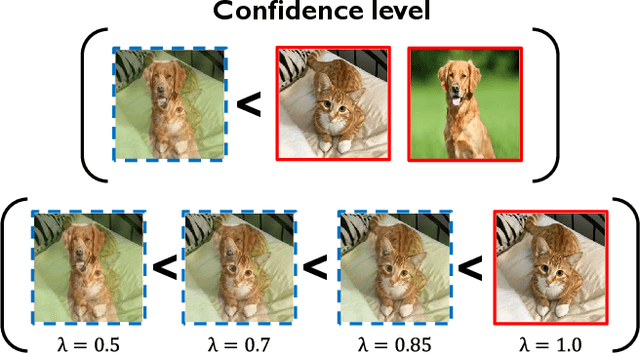

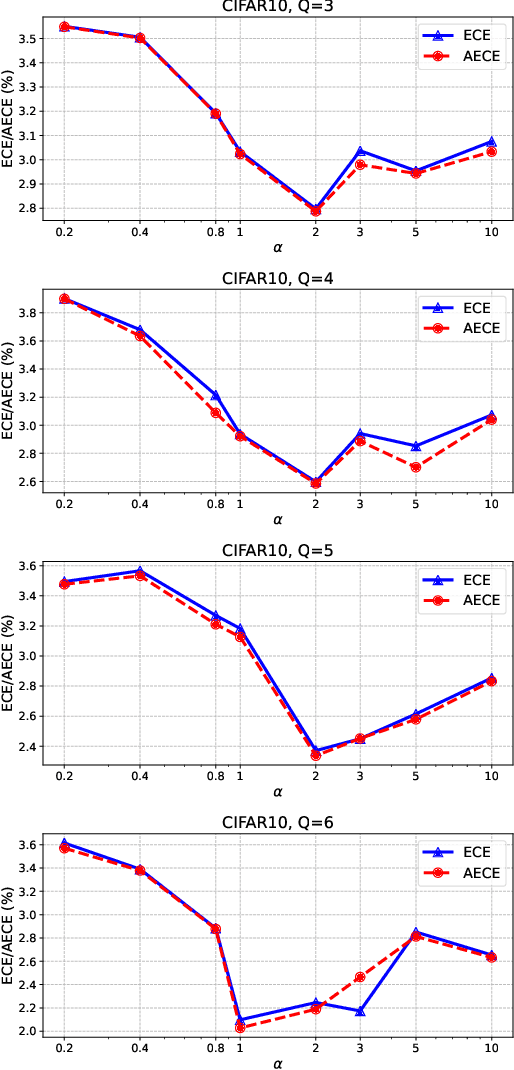
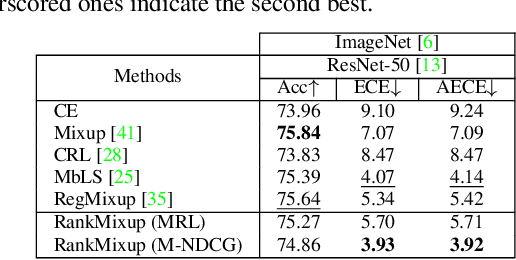
Abstract:Network calibration aims to accurately estimate the level of confidences, which is particularly important for employing deep neural networks in real-world systems. Recent approaches leverage mixup to calibrate the network's predictions during training. However, they do not consider the problem that mixtures of labels in mixup may not accurately represent the actual distribution of augmented samples. In this paper, we present RankMixup, a novel mixup-based framework alleviating the problem of the mixture of labels for network calibration. To this end, we propose to use an ordinal ranking relationship between raw and mixup-augmented samples as an alternative supervisory signal to the label mixtures for network calibration. We hypothesize that the network should estimate a higher level of confidence for the raw samples than the augmented ones (Fig.1). To implement this idea, we introduce a mixup-based ranking loss (MRL) that encourages lower confidences for augmented samples compared to raw ones, maintaining the ranking relationship. We also propose to leverage the ranking relationship among multiple mixup-augmented samples to further improve the calibration capability. Augmented samples with larger mixing coefficients are expected to have higher confidences and vice versa (Fig.1). That is, the order of confidences should be aligned with that of mixing coefficients. To this end, we introduce a novel loss, M-NDCG, in order to reduce the number of misaligned pairs of the coefficients and confidences. Extensive experimental results on standard benchmarks for network calibration demonstrate the effectiveness of RankMixup.
Decomposed Knowledge Distillation for Class-Incremental Semantic Segmentation
Oct 12, 2022



Abstract:Class-incremental semantic segmentation (CISS) labels each pixel of an image with a corresponding object/stuff class continually. To this end, it is crucial to learn novel classes incrementally without forgetting previously learned knowledge. Current CISS methods typically use a knowledge distillation (KD) technique for preserving classifier logits, or freeze a feature extractor, to avoid the forgetting problem. The strong constraints, however, prevent learning discriminative features for novel classes. We introduce a CISS framework that alleviates the forgetting problem and facilitates learning novel classes effectively. We have found that a logit can be decomposed into two terms. They quantify how likely an input belongs to a particular class or not, providing a clue for a reasoning process of a model. The KD technique, in this context, preserves the sum of two terms (i.e., a class logit), suggesting that each could be changed and thus the KD does not imitate the reasoning process. To impose constraints on each term explicitly, we propose a new decomposed knowledge distillation (DKD) technique, improving the rigidity of a model and addressing the forgetting problem more effectively. We also introduce a novel initialization method to train new classifiers for novel classes. In CISS, the number of negative training samples for novel classes is not sufficient to discriminate old classes. To mitigate this, we propose to transfer knowledge of negatives to the classifiers successively using an auxiliary classifier, boosting the performance significantly. Experimental results on standard CISS benchmarks demonstrate the effectiveness of our framework.
OIMNet++: Prototypical Normalization and Localization-aware Learning for Person Search
Jul 21, 2022



Abstract:We address the task of person search, that is, localizing and re-identifying query persons from a set of raw scene images. Recent approaches are typically built upon OIMNet, a pioneer work on person search, that learns joint person representations for performing both detection and person re-identification (reID) tasks. To obtain the representations, they extract features from pedestrian proposals, and then project them on a unit hypersphere with L2 normalization. These methods also incorporate all positive proposals, that sufficiently overlap with the ground truth, equally to learn person representations for reID. We have found that 1) the L2 normalization without considering feature distributions degenerates the discriminative power of person representations, and 2) positive proposals often also depict background clutter and person overlaps, which could encode noisy features to person representations. In this paper, we introduce OIMNet++ that addresses the aforementioned limitations. To this end, we introduce a novel normalization layer, dubbed ProtoNorm, that calibrates features from pedestrian proposals, while considering a long-tail distribution of person IDs, enabling L2 normalized person representations to be discriminative. We also propose a localization-aware feature learning scheme that encourages better-aligned proposals to contribute more in learning discriminative representations. Experimental results and analysis on standard person search benchmarks demonstrate the effectiveness of OIMNet++.
Video-based Person Re-identification with Spatial and Temporal Memory Networks
Aug 20, 2021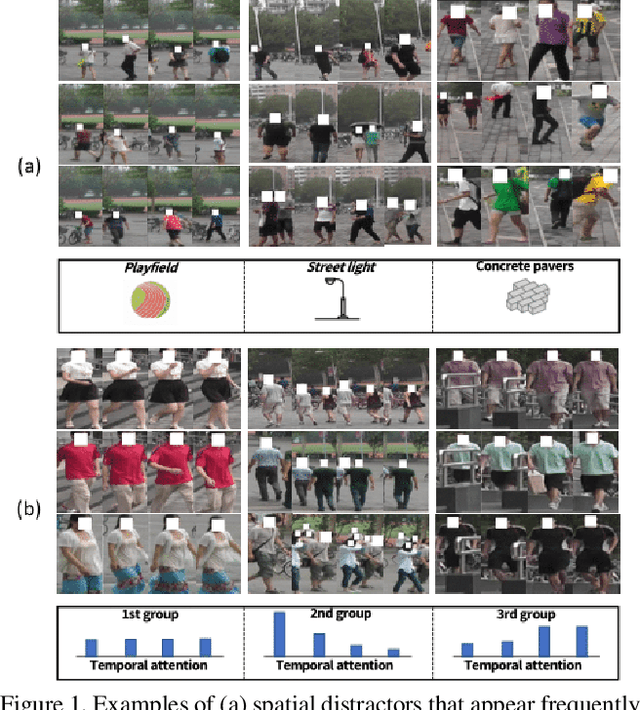
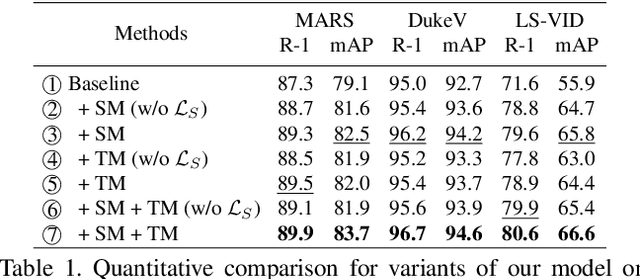
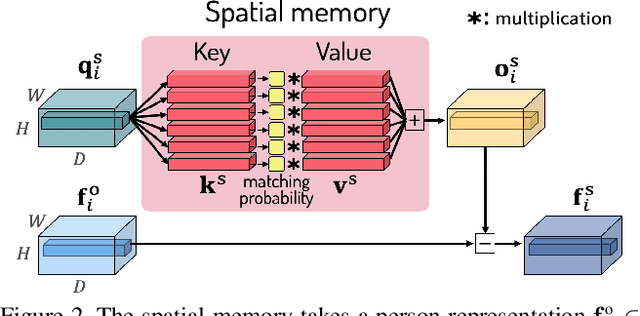
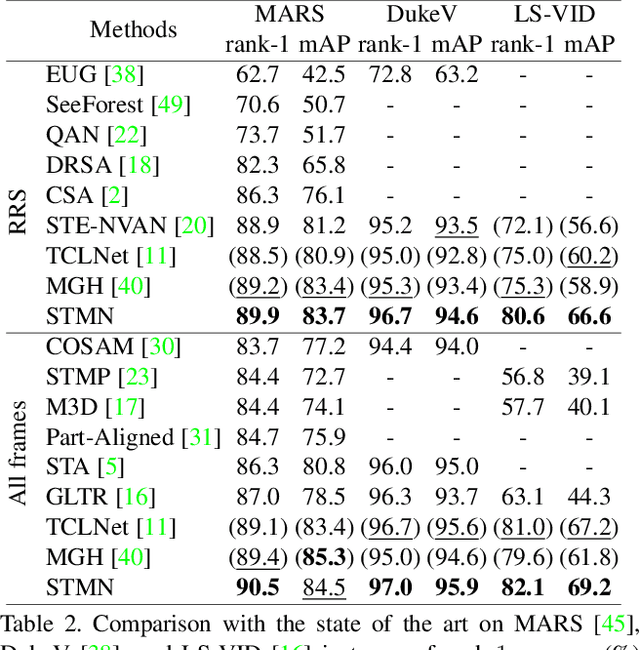
Abstract:Video-based person re-identification (reID) aims to retrieve person videos with the same identity as a query person across multiple cameras. Spatial and temporal distractors in person videos, such as background clutter and partial occlusions over frames, respectively, make this task much more challenging than image-based person reID. We observe that spatial distractors appear consistently in a particular location, and temporal distractors show several patterns, e.g., partial occlusions occur in the first few frames, where such patterns provide informative cues for predicting which frames to focus on (i.e., temporal attentions). Based on this, we introduce a novel Spatial and Temporal Memory Networks (STMN). The spatial memory stores features for spatial distractors that frequently emerge across video frames, while the temporal memory saves attentions which are optimized for typical temporal patterns in person videos. We leverage the spatial and temporal memories to refine frame-level person representations and to aggregate the refined frame-level features into a sequence-level person representation, respectively, effectively handling spatial and temporal distractors in person videos. We also introduce a memory spread loss preventing our model from addressing particular items only in the memories. Experimental results on standard benchmarks, including MARS, DukeMTMC-VideoReID, and LS-VID, demonstrate the effectiveness of our method.
Learning by Aligning: Visible-Infrared Person Re-identification using Cross-Modal Correspondences
Aug 17, 2021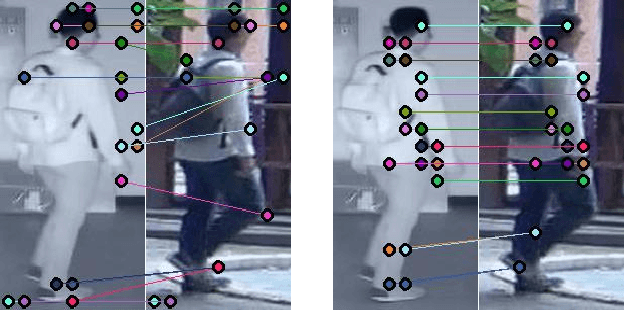
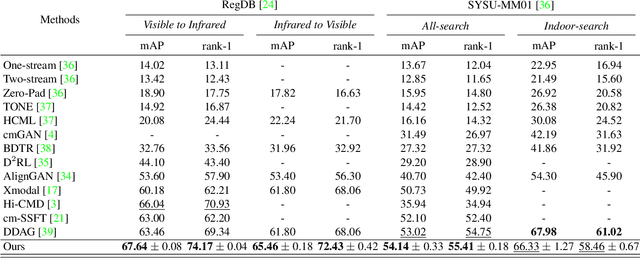
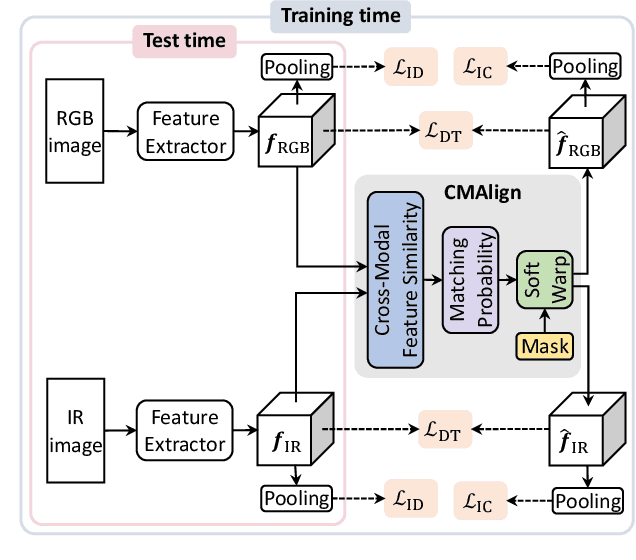
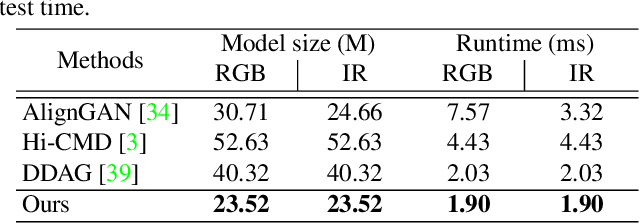
Abstract:We address the problem of visible-infrared person re-identification (VI-reID), that is, retrieving a set of person images, captured by visible or infrared cameras, in a cross-modal setting. Two main challenges in VI-reID are intra-class variations across person images, and cross-modal discrepancies between visible and infrared images. Assuming that the person images are roughly aligned, previous approaches attempt to learn coarse image- or rigid part-level person representations that are discriminative and generalizable across different modalities. However, the person images, typically cropped by off-the-shelf object detectors, are not necessarily well-aligned, which distract discriminative person representation learning. In this paper, we introduce a novel feature learning framework that addresses these problems in a unified way. To this end, we propose to exploit dense correspondences between cross-modal person images. This allows to address the cross-modal discrepancies in a pixel-level, suppressing modality-related features from person representations more effectively. This also encourages pixel-wise associations between cross-modal local features, further facilitating discriminative feature learning for VI-reID. Extensive experiments and analyses on standard VI-reID benchmarks demonstrate the effectiveness of our approach, which significantly outperforms the state of the art.
Distance-aware Quantization
Aug 16, 2021



Abstract:We address the problem of network quantization, that is, reducing bit-widths of weights and/or activations to lighten network architectures. Quantization methods use a rounding function to map full-precision values to the nearest quantized ones, but this operation is not differentiable. There are mainly two approaches to training quantized networks with gradient-based optimizers. First, a straight-through estimator (STE) replaces the zero derivative of the rounding with that of an identity function, which causes a gradient mismatch problem. Second, soft quantizers approximate the rounding with continuous functions at training time, and exploit the rounding for quantization at test time. This alleviates the gradient mismatch, but causes a quantizer gap problem. We alleviate both problems in a unified framework. To this end, we introduce a novel quantizer, dubbed a distance-aware quantizer (DAQ), that mainly consists of a distance-aware soft rounding (DASR) and a temperature controller. To alleviate the gradient mismatch problem, DASR approximates the discrete rounding with the kernel soft argmax, which is based on our insight that the quantization can be formulated as a distance-based assignment problem between full-precision values and quantized ones. The controller adjusts the temperature parameter in DASR adaptively according to the input, addressing the quantizer gap problem. Experimental results on standard benchmarks show that DAQ outperforms the state of the art significantly for various bit-widths without bells and whistles.
Network Quantization with Element-wise Gradient Scaling
Apr 02, 2021



Abstract:Network quantization aims at reducing bit-widths of weights and/or activations, particularly important for implementing deep neural networks with limited hardware resources. Most methods use the straight-through estimator (STE) to train quantized networks, which avoids a zero-gradient problem by replacing a derivative of a discretizer (i.e., a round function) with that of an identity function. Although quantized networks exploiting the STE have shown decent performance, the STE is sub-optimal in that it simply propagates the same gradient without considering discretization errors between inputs and outputs of the discretizer. In this paper, we propose an element-wise gradient scaling (EWGS), a simple yet effective alternative to the STE, training a quantized network better than the STE in terms of stability and accuracy. Given a gradient of the discretizer output, EWGS adaptively scales up or down each gradient element, and uses the scaled gradient as the one for the discretizer input to train quantized networks via backpropagation. The scaling is performed depending on both the sign of each gradient element and an error between the continuous input and discrete output of the discretizer. We adjust a scaling factor adaptively using Hessian information of a network. We show extensive experimental results on the image classification datasets, including CIFAR-10 and ImageNet, with diverse network architectures under a wide range of bit-width settings, demonstrating the effectiveness of our method.
 Add to Chrome
Add to Chrome Add to Firefox
Add to Firefox Add to Edge
Add to Edge